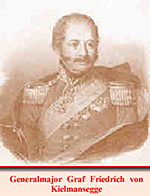Left Wing History (5):
Waterloo 1815
Vivian, Alten and the Imperial Guard
by Gary Cousins, Germany
| |
“I confidently assert, that on the part of the position upon which
the 10th and 18th Hussars were formed in line, the enemy never at this
period reached the crest. That many of their dead lay on it the next
morning there can be no doubt. During the previous attacks the cuirassiers
had passed much beyond the crest; and when I went on the
following day over the ground, I saw some few French infantry within
our line; but the mass of the enemy’s dead and dying lay below the
crest, extending away from the French left of La Haye Sainte, and
rather in rear of it.” [91]
Uncertain as they were about the identity of the troops they were
supporting, the accounts of Vivian and his brigade gave no hint that
they were engaged with the French Imperial Guard at this time. Further,
Siborne never believed that the Germans of Alten’s Division to the left
of Halkett’s Brigade – Ompteda, Kielmansegge, Kruse, the Brunswickers
– had been engaged with the Guard: in History, their operations,
after the loss of La Haie-Sainte and until the end of the battle, are dealt
with in Chapter XIII; the defeat of the Guard by Maitland’s, Adam’s
and Halkett’s Brigades is an all-British affair left until Chapter XIV. [92]
Since the loss of La Haie-Sainte, there had been plenty of French
infantry engaged in front of Alten’s Division, and it possible that this is
why the attack of the Guard struck further to Wellington’s right, and
thus avoided hitting the brigades of Ompteda and Kielmansegge – or
what remained of them – which was fortunate for the outcome.
Certainly the Hanoverian report consulted by Siborne made no explicit
claim that Ompteda’s and Kielmansegge’s Brigades faced the Guard at
the end of the day. It gave little detail of the activity of Ompteda’s
Brigade during the final French attack, but it was no longer in fighting
condition, and Siborne’s model depicted only
its “remains”. [93]
Of Kielmansegge’s Brigade, the report said that during the final attacks,
after wavering several times, the brigade had
to be completely withdrawn to be re-supplied
and restored to order, and that by the time it
rejoined the line the French were already in
retreat. There is controversy about this in the
reports of Alten and the brigade: [94] perhaps
Siborne’s History, as also his model (where it
was depicted as still in the front line), gave the
benefit to the brigade.
However, the Nassau and Brunswick reports
claimed to have had a part in the defeat
of the Guard – claims which Siborne did not
believe, so he wrote to Shaw, AQMG of
Alten’s Division in 1815, to seek clarification:
“…The accompanying sketch…shows
the disposition of the 1st Brigade of Guards
and Adam’s Brigade, at the moment of the
final attack by the French Imperial Guard. A
vacant space is left for part of the 3rd Division
which I find it very difficult to fill up, and I
have experienced more embarrassment than
assistance from the reports made to me by the
General Officer in command of the Brunswick-Oels Corps (which had then joined the
3rd Division), and by General Baron von
Kruse of Nassau…” [95]
Outlining the contents of these reports,
Siborne suggested to Shaw that these contingents
had not been engaged with the Guard,
but with the French skirmishers which took La
Haie-Sainte and emerged to attack the centre-right.
Shaw agreed:
“…[Apart from the attacks upon La Haie-Sainte]
the other attacks on the Third Division
were chiefly by immense swarms of skirmishers,
sometimes supported by cavalry & artillery,
and the attacks which you have had
reported to you as having been made by the
Nassau and Brunswick troops were not on the
Imperial Guard but upon those masses, so far
as I know…” [96]
On Siborne’s model, these contingents
were represented in the front line: but the description
said that they both gave way at about
the time of the attack of the Guard, although
they rallied, the Brunswickers “just before the
first column of the Imperial Guard was defeated”,
the Nassauers “before the attack by the
second column of the Imperial Guard.”
The End of Alten’s
Travails
“…The fire from the enemy's infantry in
front of this part of the line suddenly slackened;
and it was soon manifest that they were
falling back: the change arose out of occurrences
on their left…” [97]
Siborne wrote to Vivian, recalling the
“tremendous” fire in Vivian’s front:
“It did not however last long. Our 1st
Brigade of Guards boldly advanced against
the 1st column of Grenadiers of the Guard,
and completely defeated them, upon seeing
which the supporting columns on their left
retired down into the hollow whence they had
issued, and of course the fire in your front
slackened very considerably, being limited to
that from the Tirailleurs. Now I presume you
moved off to the right…” [98]
And with that, the final French attack,
insofar as it affected Alten’s 3rd Division and
Vivian’s 6th Cavalry Brigade, was over.
Vivian wrote:
“But we at last began to find that the shots
did not come so thick, and I discovered that
the Enemy were, instead of advancing to gain
our position, retrograding on theirs. The mo-ment
to attack was arrived, and I received
orders to advance.” [99]
But that begins a story for another time
and place…
Left Wing History (5) Vivian’s 6th (Light) Cavalry Brigade on the 18th June 1815
Left Wing History (4) Vivian’s 6th (Light) Cavalry Brigade on the 18th June 1815
Left Wing History (3) Vivian’s 6th (Light) Cavalry Brigade on the 18th June 1815
Left Wing History (2) Prussian I Corps
Left Wing History (1) Waterloo 1815: Vivian's 6th Cavalry Brigade
|
 In 1833 Vivian proudly asserted:
In 1833 Vivian proudly asserted: